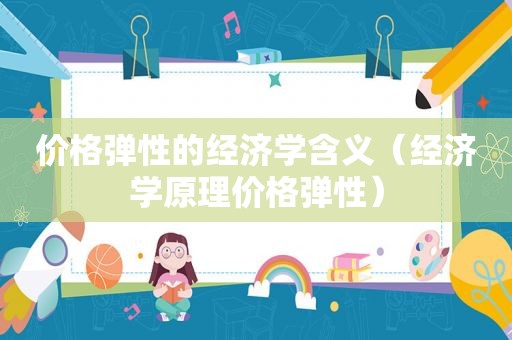本
文
摘
要

A-level economics revision guides and question banks covering labour markets, supply and demand, market structure and all core economics a-level topics.
以下内容我们会持续更新:
今天带给大家Alevel经济笔记是:
第三章:Elasticities—Price Elasticity - The Significance of Revenue
So far, we have looked at how to calculate the price elasticity of demand and illustrated the difference between elastic and inelastic demand.
This is all important bread and butter stuff, but examiners want you to show that you can discuss the significance of these values with reference, in particular, to a firms revenue.
What is the point, after all, of a firm knowing the elasticity of demand for the product he sells?
The answer is that if he can assess what the change in his sales will be for a given change in the price of his product, and then he can work out the change in his revenue.
到目前为止,我们已经研究了如何计算需求的价格弹性,并说明了弹性需求和非弹性需求之间的区别。这些都是重要的“面包和黄油”东西,但审查员希望您表明您可以讨论这些价值的重要性,特别是参考公司的收入。毕竟,一家公司知道他销售的产品的需求弹性有什么意义呢?答案是,如果他能够评估在给定产品价格变化的情况下他的销售额会发生什么变化,那么他就可以计算出他的收入变化。
Below is the question about the greengrocer and his bananas from earlier. The question has now been extended to consider the effect on revenue:
下面是关于蔬菜水果商和他的香蕉的问题。这个问题现在已经扩展到考虑对收入的影响:
A greengrocer decides to cut the price of his bananas from 40p per lb to 32p per lb. The price elasticity of demand for this product is 2. He currently sells 80lbs of bananas a day. How many will he sell after the price cut? What is the effect of this decision on the greengrocers revenue?
一位蔬菜水果商决定将他的香蕉价格从每磅 40 便士降低到每磅 32 便士。该产品的需求价格弹性为 2。他目前每天销售 80 磅香蕉。降价后他能卖多少?这个决定对蔬菜水果商的收入有什么影响?
We already know the answer to the first question. The greengrocers sales increase to 112lbs of bananas. But what will happen to his revenue?
我们已经知道第一个问题的答案。蔬菜水果商的香蕉销量增加到 112 磅。但他的收入会怎样?
Revenue before the price cut:
Revenue = price × quantity sold = 40p × 80lbs = £32.00
Revenue after the price cut:
Revenue = price × quantity sold = 32p × 112lbs = £35.84
降价前收入:
收入 = 价格 × 销量 = 40p × 80lbs = £32.00
降价后收入:
收入 = 价格 × 销量 = 32p × 112lbs = £35.84
So the price cut causes revenue to increase.
This may seem odd at first glance, but remember that the demand for bananas was 2, which is relatively elastic.
This means that the rise in demand as a result of the price cut was proportionately higher than the fall in price.
In other words, although the greengrocers receives 8p less for each of the 80lbs that he used to sell, he sells so many more bananas at the new lower price that his total revenue rises.
I think that this is best illustrated with a diagram:
因此,降价导致收入增加。乍一看这可能看起来很奇怪,但请记住,香蕉的需求是 2,这是相对弹性的。这意味着由于价格下降而导致的需求上升成比例地高于价格下降。换句话说,尽管蔬菜水果商每卖出 80 磅香蕉,他的收入减少了 8 便士,但他以新的更低价格卖出了更多的香蕉,以至于他的总收入增加了。我认为最好用图表来说明这一点:
Notice that the demand curve drawn is relatively flat, signifying that the demand for bananas is relatively elastic.
The red box marked loss represents the loss in revenue due to the fact that the first 80lbs of bananas are sold at a lower price. The green box marked gain represents the extra revenue received as a result of selling 32 extra lbs of bananas at the lower price.
It is fairly easy to see that the gain box is larger than the loss box, so the greengrocers total revenue has increased.
注意绘制的需求曲线比较平坦,说明香蕉的需求比较有弹性。标有“损失”的红框表示由于前 80 磅香蕉以较低价格出售而导致的收入损失。标有“收益”的绿色方框代表以较低价格多卖 32 磅香蕉而获得的额外收入。很容易看出“收益”框大于“损失”框,因此蔬菜水果商的总收入增加了。
What would have happened if the greengrocer (not understanding elasticities!) had tried to increase his revenue by raising the price to, say, 44p per lb (ceteris paribus)?
如果蔬菜水果商(不了解弹性!)试图通过将价格提高到每磅 44 便士(其他条件不变)来增加他的收入,会发生什么?
Revenue before the price increase:
Revenue = price × quantity sold = 40p × 80lbs = £32.00
Revenue after the price increase:
Revenue = price × quantity sold = 44p × 64lbs = £28.16
涨价前收入:
收入 = 价格 × 销量 = 40p × 80lbs = £32.00
涨价后收入:
收入 = 价格 × 销量 = 44p × 64lbs = £28.16
He sells 20% fewer lbs of bananas.他的香蕉销量减少了 20%。
What are the implications of price changes if a firm faces a relatively inelastic demand curve? The diagrams below show us what they are:
如果公司面临相对缺乏弹性的需求曲线,价格变化的影响是什么?下图向我们展示了它们是什么:
Petrol is a good with relatively inelastic demand. Let us assume that the value of the elasticity is 0.5, the initial price is 80p per litre and this gives sales of 4000 litres per day.
汽油是一种需求相对缺乏弹性的商品。让我们假设弹性值为 0.5,初始价格为每升 80 便士,因此每天的销售额为 4000 升。
The diagram on the left shows us what happens to the forecourts revenue when the price is cut to 72p per litre.
This 10% cut in the price will lead to an increase in demand of only 5% (as the elasticity is only 0.5).
The new demand will be 4200 litres. So the change in revenue can be calculated:
左边的图表向我们展示了当价格降至每升 72 便士时前院的收入会发生什么变化。价格下降 10% 将导致需求仅增加 5%(因为弹性仅为 0.5)。新的需求将是 4200 升。因此可以计算收入的变化:
Revenue before the price cut:
Revenue = price × quantity sold = 80p × 4000 litres = £3200
Revenue after the price cut:
Revenue = price × quantity sold = 72p × 4200 litres = £3024
降价前收入:收入 = 价格 × 销量 = 80p × 4000 升 = £3200
降价后收入:收入 = 价格 × 销售量 = 72p × 4200 升 = £3024
This fall in total revenue is illustrated in the diagram, where the loss box is much bigger than the gain box.
图表中说明了总收入的下降,其中“损失”框比“收益”框大得多。
The diagram on the right shows us what happens if the forecourt manager decides to raise the price to 88p per litre.
This 10% rise in the price will lead to a fall in demand, but by only 5%. The new demand will be 3800 litres. Again, we can calculate the change in revenue:
右图向我们展示了如果前庭经理决定将价格提高到每升 88 便士会发生什么。价格上涨 10% 将导致需求下降,但仅下降 5%。新的需求将是 3800 升。同样,我们可以计算收入的变化:
Revenue before the price cut:
Revenue = price × quantity sold = 80p × 4000 litres = £3200
Revenue after the price cut:
Revenue = price × quantity sold = 88p × 3800 litres = £3344
降价前收入:收入 = 价格 × 销量 = 80p × 4000 升 = £3200
降价后收入:收入 = 价格 × 销量 = 88p × 3800 升 = £3344
This rise in total revenue is illustrated in the diagram on the right, where the gain box is much bigger than the loss box.
右图说明了总收入的增长,其中“收益”框比“损失”框大得多。
So, to summarise:所以,总结一下:
Value of the elasticity
Price rise or cut?
What will happen to the quantity demanded?
Will total revenue rise or fall?
Ed = 0
Price rise
The demand curve is vertical, so demand remains the same but with a higher price.
Rise
(Perfectly inelastic)
Price cut
The demand curve is vertical, so demand remains the same but with a lower price.
Fall
0 < Ed 1
Price rise
The demand curve is relatively steep, so the fall in demand will be proportionately *** aller than the rise in price.
Rise
(Relatively inelastic)
Price cut
The demand curve is relatively steep, so the rise in demand will be proportionately *** aller than the cut in price.
Fall
Ed = 1
(Unitary elasticity)
Price rise or a price cut
The demand curve is a parabola, so the change in price (up or down) will be proportionately the same as the change in demand.
Unchanged Revenue
1 < Ed < ∞
Price rise
The demand curve is relatively flat, so the fall in demand will be proportionately larger than the rise in price.
Fall
(Relatively elastic)
Price cut
The demand curve is relatively flat, so the rise in demand will be proportionately larger than the cut in price.
Rise
Note that infinite elasticity has not been included in the table. In is assumed that the price must remain constant when the demand curve is horizontal.
请注意,表中未包含无限弹性。假设当需求曲线是水平的时价格必须保持不变。
关于Alevel经济笔记第三章:Elasticities后续的更新计划如下:

